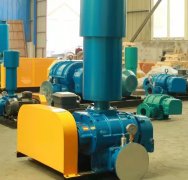Aquaculture wastewater treatment must see! How to choose Roots blower?
The aeration application of Roots blower in aquaculture wastewater treatment is very important. The following is a detailed explanation of its application and selection:
application
1. Increase oxygen content in water bodies:
The Roots blower sends air into the water through aeration facilities, effectively increasing the oxygen content of the water. This oxygen supply method meets the basic survival needs of aquatic organisms and promotes their healthy growth and reproduction.
2. Improving water quality:
The Roots blower, through its powerful airflow, can accelerate convection in water bodies and make water quality more uniform.
At the same time, Roots blowers can also help remove pollutants and harmful substances (such as suspended solids, ammonia nitrogen, nitrite, etc.) in water bodies, thereby improving the cleanliness and transparency of the water.
3. Regulating the water environment:
Roots blowers can adjust parameters such as water temperature and pH value according to aquaculture needs.
By controlling the operating time and air volume of the fan, it is possible to regulate the water environment and provide a more suitable growth environment for aquatic organisms.
4. Wastewater treatment:
During the process of aquaculture, a large amount of wastewater is generated, which contains waste and nutrients such as nitrogen and phosphorus.
Roots blower can be used for aeration and agitation of sewage, promoting the activity and reproduction of microorganisms. These microorganisms can decompose waste and harmful substances in wastewater, transforming them into harmless or low toxic substances, thereby reducing water pollution and improving water quality.
model selection
1. Breeding species and breeding area:
Determine the model and quantity of Roots blowers based on the types and quantities of aquatic organisms such as fish and shrimp in aquaculture, as well as the size of the aquaculture area.
Ponds with large aquaculture areas and high densities require greater air flow and higher pressure to ensure sufficient dissolved oxygen and water agitation.
2. Water depth:
Water depth is also an important consideration in selection. Deeper ponds require higher pressure to ensure that air can fully diffuse to the bottom of the water.
3. Aeration method:
Choose the appropriate Roots blower based on the aeration method of the aquaculture pond (such as bottom aeration, top aeration, etc.).
Different aeration methods require different air volumes and pressures to ensure aeration effectiveness.
4. Pipeline length and diameter:
The length and diameter of the gas pipeline will also affect the selection of the fan.
The longer the pipeline and the smaller the diameter, the greater the required pressure, so it is necessary to choose a Roots blower with higher pressure.
5. Performance stability:
Choose a Roots blower with stable performance and sufficient air output to ensure continuous provision of sufficient oxygen and improvement of water quality environment during aquaculture.
6. Noise and maintenance:
Considering the noise level of the fan and its impact on the environment, choose a model with lower noise.
At the same time, understand the maintenance requirements of the fan and choose models that are easy to repair and maintain to reduce operating costs.
In summary, the application of Roots blower in aeration of aquaculture wastewater treatment plays an important role. Through reasonable selection and use, the role of Roots blowers in aquaculture can be ensured, improving aquaculture efficiency and water production.



